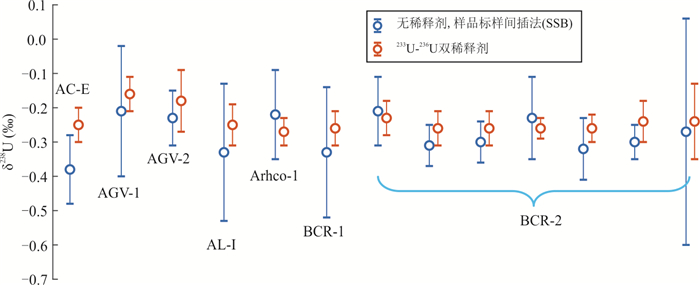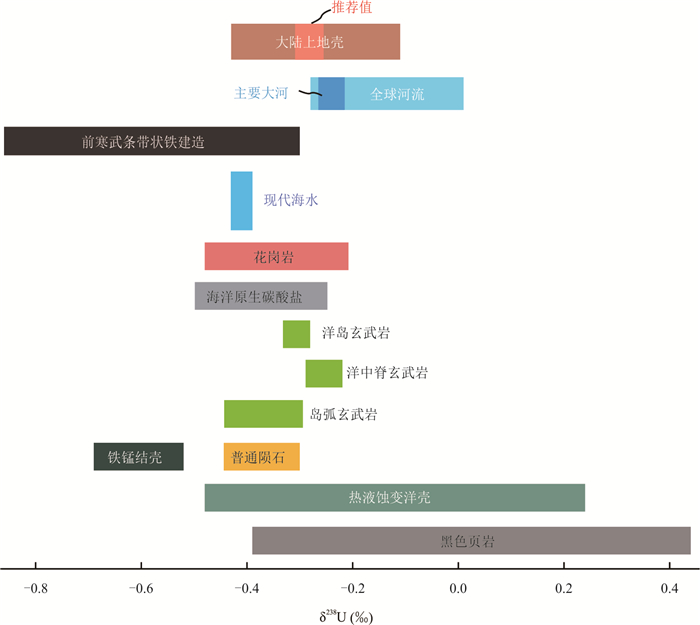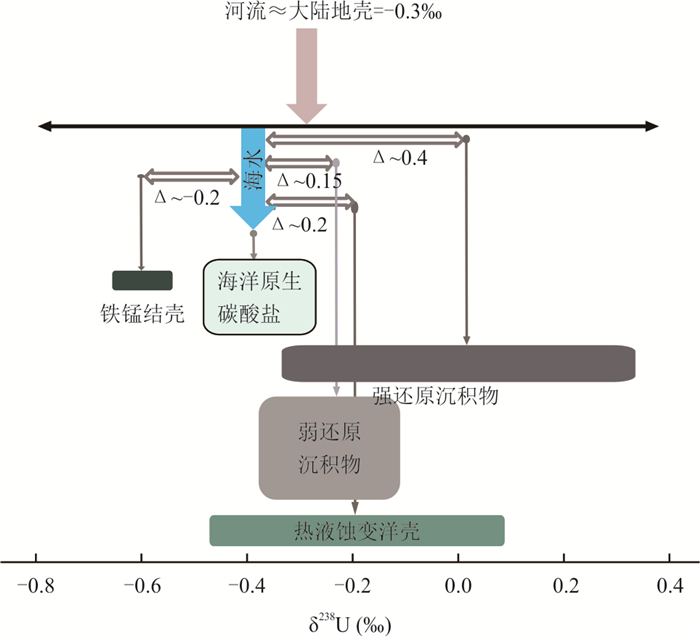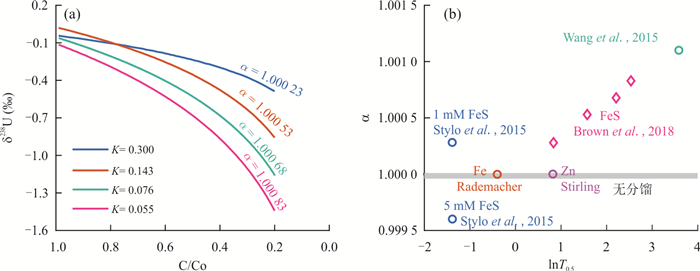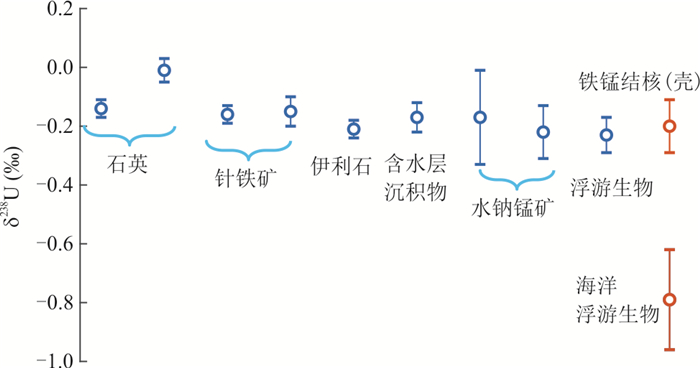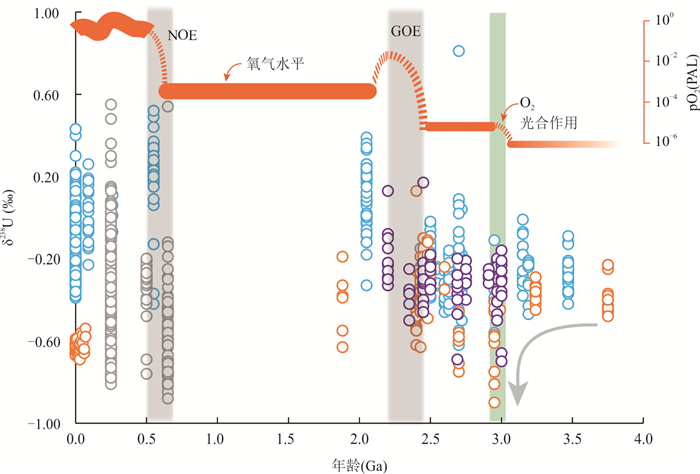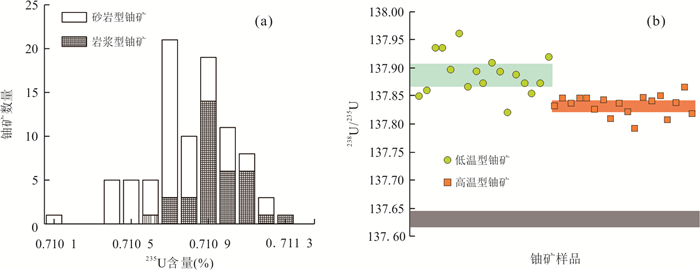Uranium "Stable" Isotope Fractionation and Its Applications in Earth Science
-
摘要: 铀“稳定”同位素(238U/235U,通常记为δ238U)目前已经成为非传统稳定同位素领域的研究热点.20世纪人们曾经认为铀同位素不存在分馏,因而铀同位素研究发展缓慢.然而随着分析技术的发展,人们发现自然界中铀同位素238U和235U存在显著的分馏,可以作为良好的示踪工具.迄今为止,已经有大量铀同位素作为古氧化还原指标的研究发表,比如用铀同位素示踪地球近地表环境氧含量随时间的演化以及生物大灭绝与海洋氧化还原状态之间的潜在关系.尽管铀同位素在水圈和生物圈协同演化领域取得了丰硕的研究成果,但仍有不少问题亟待深入解决.例如,生物和非生物还原高价铀的微观反应过程对铀同位素分馏的影响,以及铀同位素如何示踪铀矿物质来源等.系统总结了铀同位素地球化学最近十年的研究进展,希望将来铀同位素在铀多金属矿床成因和高温地球化学领域能有所突破.Abstract: Uranium isotope (238U/235U, usually expressed as δ238U) has been the research hotspot in the field of non-traditional stable isotopes. In the last century, it was thought that uranium isotope fractionation did not exist, so the development of uranium isotope research was very slow. However, with the development of the analytical technology, it has been found that there exists significant fractionation between238U and 235U in nature, which makes uranium isotopes an ideal tracer in Earth science. Indeed, overwhelming amounts of studies of uranium isotopes as a paleo-redox proxy have been published so far, most of which use uranium isotope to track the evolution of oxygen levels of Earth's subaerial environments through time and, furthermore, the potential relationship between the several big mass extinctions and the redox conditions of the oceans. Although researches on uranium isotope have achieved progresses in the co-evolution of the hydrosphere and biosphere, some problems still remain some unsolved. For example, the effects of microcosmic pathways of biological and abiotic reduction reactions on uranium isotope fractionation, and how the 238U/235U can trace the source of uranium ore deposits. Here, in this paper, it provides an overview of the uranium and its isotope geochemistry over the last decades, aiming at promoting applications of uranium isotopes in the genesis of uranium polymetallic deposits and high-temperature geochemistry in the future.
-
Key words:
- uranium isotopes /
- fractionation mechanism /
- tracer /
- oxygen level /
- mass extinction /
- redox condition /
- U ore deposit /
- geochemistry
-
图 1 Th和U元素在铀特效树脂U-TEVA的分配系数(Kd)随酸硝酸和盐酸浓度的变化(数据引自Tissot and Dauphas, 2015)
Fig. 1. The distribution coefficients of Th and U on U-TEVA resin in the concentration of HNO3 and HCl (data sources are from Tissot and Dauphas, 2015)
图 2 用双稀释剂和只用样品标样间插法(SSB)法得到的铀同位素结果对比(数据来源于Tissot and Dauphas, 2015)
Fig. 2. Comparison of uranium isotope compositions obtained from double spike and just sample-standard bracketing(data sources are from Tissot and Dauphas, 2015)
图 3 自然界主要的铀同位素储库
数据来源:Stirling et al.(2007);Weyer et al.(2008);Romaniello et al.(2013);Montoya-Pino et al.(2010);Noordmann et al.(2012, 2016);Telus et al.(2012);Andersen et al.(2014, 2015, 2017);Goto et al.(2014);Goldmann et al.(2015);Tissot and Dauphas(2015);Wang et al.(2016);Rolison et al.(2017);图修改自Tissot and Dauphas(2015)
Fig. 3. Uranium isotope compositions of main reservoirs in narure
图 4 海洋系统铀同位素储库与质量平衡示意
铀同位素平衡关系为:δ238U河流=δ238U强还原×f强还原+δ238U弱还原×f弱还原+δ238U原生碳酸盐×f原生碳酸盐+ δ238U铁锰结壳×f铁锰结壳+ δ238U热液蚀变物质×f热液蚀变物质,f为各个储库所占比例.数据来源于Stirling et al.(2007);Weyer et al.(2008);Romaniello et al.(2009);Montoya-Pino et al.(2010);Noordmann et al.(2012, 2016);Andersen et al.(2014, 2015, 2017);Goto et al.(2014);Tissot and Dauphas(2015);Wang et al.(2016);Rolison et al.(2017);图修改自Tissot and Dauphas(2015)和Andersen et al.(2017);三角形符号代表不同储库与海水之间的分馏程度
Fig. 4. Uranium isotope compositions of main reservoirs or sinks in ocean
图 5 全球铀循环卡通示意
其中AOC代表蚀变洋壳;MORB代表洋中脊玄武岩;OIB代表洋岛玄武岩;ARC代表大洋岛弧.图修改自Andersen et al.(2015)
Fig. 5. Cartoon of the terrestrial U isotope cycle over the history of Earth
图 6 反应进程中溶液中剩余的U6+的同位素组成
K为反应速率常数,K越大,反应速率越快.如图a所示,化学反应速率越快,分馏的程度就越小;反之就越大.图b为不同方法消耗原始溶液中U的反应进程(用lnT0.5来表征)与分馏因子α的相关性.数据引自Rademacher et al.(2006);Stirling et al.(2007);Stylo et al.(2015);Wang et al.(2015a);Brown et al.(2018)
Fig. 6. δ238U of dissolved uranium in the solution for each reaction rate as a function of remaining aqueous U fraction (a); Relationship between the half-life of aqueous U (representing the extent of U removal from solution) and the isotopic fractionation factor (α) in different experiments of previous studies (b)
图 7 吸附过程中溶解铀和被吸附的铀之间的同位素分馏.尽管实验所用吸附剂不同,铀同位素分馏程度基本在0.17‰~0.23‰
橘黄色圆圈代表实际观测到的海洋铁锰结核、海洋浮游植物与海水之间的偏差;数据来源Weyer et al.(2008);Brennecka et al.(2011a);Goto et al.(2014);Jemison et al.(2016);Wang et al.(2016);Chen et al.(2020)
Fig. 7. δ238U offset between dissolved and adsorbed uranium. Different adsorbents show basically close offset between -0.17‰ and -0.23‰
图 8 溶解态的铀被吸附到铁锰氧化物表面的吸附机理(修改自Dang et al., 2016).碳酸铀酰在吸附前后U-O键键长发生了改变(Dang et al., 2016)
Fig. 8. Postulated models of U adsorption on Fe and Mn oxides(modified from Dang et al., 2016). Ball-and-stick representation of the dissolved uranyl carbonate complex. Note that the length of U-O band changes after adsorption(Dang et al., 2016)
图 9 不同时代碳酸盐岩(灰色符号)、古土壤(紫色符号)、富铁沉积物(橙色符号)和页岩(蓝色符号)铀同位素组成
数据来源:Weyer et al.(2008);Montoya-Pino et al.(2010);Brennecka et al.(2011a);Asael et al.(2013);Kendall et al.(2013, 2015);Andersen et al.(2014);Dahl et al.(2014);Goto et al.(2014);Holmden et al.(2015);Noordmann et al.(2015);Elrick et al.(2017);Hinojosa et al.(2016);Lau et al.(2016, 2017);Wang et al.(2016, 2018);Rolison et al.(2017)
Fig. 9. Variation of uranium isotope compositions for shales (blue circles), carbonate (gray circles), iron-rich (orange circles) and paleosol (purple circles) through time
图 10 现今海洋富氧(a)和地质历史时期缺氧(b)状态下海水的铀同位素质量平衡(修改自Brennecka et al., 2011a)
Fig. 10. Schematic illustration of the isotopic U mass balance of the modern oxygenated ocean (a) and anoxic ocean in ancient times (b) (modified from Brennecka et al., 2011a)
图 11 两种不同类型的铀矿: 低温砂岩型铀矿和高温岩浆型铀矿的235U含量(a)(Cowan and Adler, 1976; Bopp et al., 2009)和铀同位素238U/235U组成(b)(修改自Bopp et al., 2009;Brennecka et al., 2010).这些数据表明,高温型铀矿较为富集235U,而低温型铀矿铀238U含量相对较高
Fig. 11. Histogram of 235U contents for sandstone U ores and magmatic U ores (a) studied by Cowan and Adler (1976) and Bopp et al.(2009); uranium isotope compositions for low-temperature and high-temperature deposits (b) (modified from Bopp et al., 2009; Brennecka et al., 2010). Colored bars are the 2 standard error confidence intervals for each style of U ores
表 1 利用U-TEVA树脂分离铀步骤
Table 1. Separation protocol of U on U/TEVA
步骤 加酸介质 体积 目的 清洗柱 0.05 M HCl 20 mL 清洗柱 平衡柱 3 M HNO3 6 mL 上样 3 M HNO3 10 mL 淋洗 3 M HNO3 40 mL 仅保留Th、U和Np 盐酸介质 11 M HCl 6 mL 接Th,Np 5 M HCl+0.1 M oxalic 20 mL 洗掉Th、Np 去草酸 5 M HCl 10 mL 接U 0.05 M HCl 25 mL 回收U 注:引自 Weyer et al.(2008) ;Tissot and Dauphas(2015). -
Abe, M., Suzuki, T., Fujii, Y., et al., 2008. An Ab Initio Molecular Orbital Study of the Nuclear Volume Effects in Uranium Isotope Fractionations. The Journal of Chemical Physics, 129: 164309. https://doi.org/10.1063/1.2992616 Algeo, T., Henderson, C.M., Ellwood, B., et al., 2012. Evidence for a Diachronous Late Permian Marine Crisis from the Canadian Arctic Region. Geological Society of America Bulletin, 124(9-10): 1424-1448. https://doi.org/10.1130/b30505.1 doi: 10.1130/B30505.1 Anbar, A.D., Knab, K.A., Barling, J., 2001. Precise Determination of Mass-Dependent Variations in the Isotopic Composition of Molybdenum Using MC-ICPMS. Analytical Chemistry, 73(7): 1425-1431. https://doi.org/10.1021/ac000829w Andersen, M.B., Elliott, T., Freymuth, H., et al., 2015. The Terrestrial Uranium Isotope Cycle. Nature, 517: 356-359. https://doi.org/10.1038/nature14062 Andersen, M.B., Romaniello, S., Vance, D., et al., 2014. A Modern Framework for the Interpretation of 238U/235U in Studies of Ancient Ocean Redox. Earth and Planetary Science Letters, 400: 184-194. https://doi.org/10.1016/j.epsl.2014.05.051 Andersen, M.B., Stirling, C.H., Weyer, S., 2017. Uranium Isotope Fractionation. Reviews in Mineralogy and Geochemistry, 82(1): 799-850. https://doi.org/10.2138/rmg.2017.82.19 Andersen, M.B., Vance, D., Morford, J.L., et al., 2016. Closing in on the Marine 238U/235U Budget. Chemical Geology, 420: 11-22. https://doi.org/10.1016/j.chemgeo.2015.10.041 Anderson, R.F., Fleisher, M.Q., LeHuray, A.P., 1989. Concentration, Oxidation State, and Particulate Flux of Uranium in the Black Sea. Geochimica et Cosmochimica Acta, 53(9): 2215-2224. https://doi.org/10.1016/0016-7037(89)90345-1 Asael, D., Tissot, F.L.H., Reinhard, C.T., et al., 2013. Coupled Molybdenum, Iron and Uranium Stable Isotopes as Oceanic Paleoredox Proxies during the Paleoproterozoic Shunga Event. Chemical Geology, 362: 193-210. https://doi.org/10.1016/j.chemgeo.2013.08.003 Bach, W., Peucker-Ehrenbrink, B., Hart, S.R., et al., 2003. Geochemistry of Hydrothermally Altered Oceanic Crust: DSDP/ODP Hole 504B-Implications for Seawater-Crust Exchange Budgets and Sr- and Pb-Isotopic Evolution of the Mantle. Geochemistry, Geophysics, Geosystems, 4(3): 8904. https://doi.org/10.1029/2002gc000419 Barnes, C.E., Cochran, J.K., 1990. Uranium Removal in Oceanic Sediments and the Oceanic U Balance. Earth and Planetary Science Letters, 97(1-2): 94-101. https://doi.org/10.1016/0012-821x(90)90101-3 doi: 10.1016/0012-821X(90)90101-3 Basu, A., Sanford, R.A., Johnson, T.M., et al., 2014. Uranium Isotopic Fractionation Factors during U(Ⅵ) Reduction by Bacterial Isolates. Geochimica et Cosmochimica Acta, 136: 100-113. https://doi.org/10.1016/j.gca.2014.02.041 Basu, A., Wanner, C., Johnson, T.M., et al., 2020. Microbial U Isotope Fractionation Depends on the U(Ⅵ) Reduction Rate. Environmental Science & Technology, 54(4): 2295-2303. https://doi.org/10.1021/acs.est.9b05935 Bekker, A., Holland, H.D., 2012. Oxygen Overshoot and Recovery during the Early Paleoproterozoic. Earth and Planetary Science Letters, 317-318: 295-304. https://doi.org/10.1016/j.epsl.2011.12.012 Bell, E.A., Harrison, T.M., McCulloch, M.T., et al., 2011. Early Archean Crustal Evolution of the Jack Hills Zircon Source Terrane Inferred from Lu-Hf, 207Pb/206Pb, and δ18O Systematics of Jack Hills Zircons. Geochimica et Cosmochimica Acta, 75(17): 4816-4829. https://doi.org/10.1016/j.gca.2011.06.007 Bellefroid, E.J., Hood, A.V.S., Hoffman, P.F., et al., 2018. Constraints on Paleoproterozoic Atmospheric Oxygen Levels. Proceedings of the National Academy of Sciences of the United States of America, 115(32): 8104-8109. https://doi.org/10.1073/pnas.1806216115 Bigeleisen, J., 1996a. Nuclear Size and Shape Effects in Chemical Reactions. Isotope Chemistry of the Heavy Elements. Journal of the American Chemical Society, 118(15): 3676-3680. https://doi.org/10.1021/ja954076k Bigeleisen, J., 1996b. Temperature Dependence of the Isotope Chemistry of the Heavy Elements. Proceedings of the National Academy of Sciences, 93(18): 9393-9396. https://doi.org/10.1073/pnas.93.18.9393 Blichert-Toft, J., Albarède, F., 2008. Hafnium Isotopes in Jack Hills Zircons and the Formation of the Hadean Crust. Earth and Planetary Science Letters, 265(3-4): 686-702. https://doi.org/10.1016/j.epsl.2007.10.054 Bopp, C.J., Lundstrom, C.C., Johnson, T.M., et al., 2009. Variations in 238U/235U in Uranium Ore Deposits: Isotopic Signatures of the U Reduction Process? Geology, 37(7): 611-614. https://doi.org/10.1130/g25550a.1 doi: 10.1130/G25550A.1 Brennecka, G.A., Borg, L.E., Hutcheon, I.D., et al., 2010. Natural Variations in Uranium Isotope Ratios of Uranium Ore Concentrates: Understanding the 238U/235U Fractionation Mechanism. Earth and Planetary Science Letters, 291(1-4): 228-233. https://doi.org/10.1016/j.epsl.2010.01.023 Brennecka, G.A., Herrmann, A.D., Algeo, T.J., et al., 2011a. Rapid Expansion of Oceanic Anoxia Immediately before the End-Permian Mass Extinction. Proceedings of the National Academy of Sciences of the United States of America, 108(43): 17631-17634. https://doi.org/10.1073/pnas.1106039108 Brennecka, G.A., Wasylenki, L.E., Bargar, J.R., et al., 2011b. Uranium Isotope Fractionation during Adsorption to Mn-Oxyhydroxides. Environmental Science & Technology, 45(4): 1370-1375. https://doi.org/10.1021/es103061v Brown, S.T., Basu, A., Ding, X., et al., 2018. Uranium Isotope Fractionation by Abiotic Reductive Precipitation. Proceedings of the National Academy of Sciences, 115(35): 8688-8693. https://doi.org/10.1073/pnas.1805234115 Brüske, A., Martin, A.N., Rammensee, P., et al., 2020. The Onset of Oxidative Weathering Traced by Uranium Isotopes. Precambrian Research, 338: 105583. https://doi.org/10.1016/j.precamres.2019.105583 Burnham, A.D., Berry, A.J., 2017. Formation of Hadean Granites by Melting of Igneous Crust. Nature Geoscience, 10(6): 457-461. https://doi.org/10.1038/ngeo2942 Canfield, D.E., Poulton, S.W., Narbonne, G.M., 2007. Late-Neoproterozoic Deep-Ocean Oxygenation and the Rise of Animal Life. Science, 315(5808): 92-95. https://doi.org/10.1126/science.1135013 Cao, C.Q., Love, G.D., Hays, L.E., et al., 2009. Biogeochemical Evidence for Euxinic Oceans and Ecological Disturbance Presaging the End-Permian Mass Extinction Event. Earth and Planetary Science Letters, 281(3-4): 188-201. https://doi.org/10.1016/j.epsl.2009.02.012 Chase, C.G., 1981. Oceanic Island Pb: Two-Stage Histories and Mantle Evolution. Earth and Planetary Science Letters, 52(2): 277-284. https://doi.org/10.1016/0012-821x(81)90182-5 doi: 10.1016/0012-821X(81)90182-5 Chen, J.H., Wasserburg, G.J., 1980. A Search for Isotopic Anomalies in Uranium. Geophysical Research Letters, 7(4): 275-278. https://doi.org/10.1029/gl007i004p00275 doi: 10.1029/GL007i004p00275 Chen, X.M., Romaniello, S.J., Anbar, A.D., 2017. Uranium Isotope Fractionation Induced by Aqueous Speciation: Implications for U Isotopes in Marine CaCO3 as a Paleoredox Proxy. Geochimica et Cosmochimica Acta, 215: 162-172. https://doi.org/10.1016/j.gca.2017.08.006 Chen, X.M., Romaniello, S.J., Herrmann, A.D., et al., 2016. Uranium Isotope Fractionation during Coprecipitation with Aragonite and Calcite. Geochimica et Cosmochimica Acta, 188: 189-207. https://doi.org/10.1016/j.gca.2016.05.022 Chen, X.M., Romaniello, S.J., Herrmann, A.D., et al., 2018a. Biological Effects on Uranium Isotope Fractionation (238U/235U) in Primary Biogenic Carbonates. Geochimica et Cosmochimica Acta, 240: 1-10. https://doi.org/10.1016/j.gca.2018.08.028 Chen, X.M., Romaniello, S.J., Herrmann, A.D., et al., 2018b. Diagenetic Effects on Uranium Isotope Fractionation in Carbonate Sediments from the Bahamas. Geochimica et Cosmochimica Acta, 237: 294-311. https://doi.org/10.1016/j.gca.2018.06.026 Chen, X.M., Zheng, W., Anbar, A.D., 2020. Uranium Isotope Fractionation (238U/235U) during U(Ⅵ) Uptake by Freshwater Plankton. Environmental Science & Technology, 54(5): 2744-2752. https://doi.org/10.1021/acs.est.9b06421 Chernyshev, I.V., Dubinina, E.O., Golubev, V.N., 2014. Fractionation Factor of 238U and 235U Isotopes in the Process of Hydrothermal Pitchblende Formation: A Numerical Estimate. Geology of Ore Deposits, 56(5): 315-321. https://doi.org/10.1134/s1075701514050031 doi: 10.1134/S1075701514050031 Condon, D.J., McLean, N., Noble, S.R., et al., 2010. Isotopic Composition (238U/235U) of Some Commonly Used Uranium Reference Materials. Geochimica et Cosmochimica Acta, 74(24): 7127-7143. https://doi.org/10.1016/j.gca.2010.09.019 Cowan, G.A., Adler, H.H., 1976. The Variability of the Natural Abundance of 235U. Geochimica et Cosmochimica Acta, 40(12): 1487-1490. https://doi.org/10.1016/0016-7037(76)90087-9 Cuney, M., 2010. Evolution of Uranium Fractionation Processes through Time: Driving the Secular Variation of Uranium Deposit Types. Economic Geology, 105(3): 553-569. https://doi.org/10.2113/gsecongeo.105.3.553 Dahl, T.W., Boyle, R.A., Canfield, D.E., et al., 2014. Uranium Isotopes Distinguish Two Geochemically Distinct Stages during the Later Cambrian SPICE Event. Earth and Planetary Science Letters, 401: 313-326. https://doi.org/10.1016/j.epsl.2014.05.043 Dang, D.H., Novotnik, B., Wang, W., et al., 2016. Uranium Isotope Fractionation during Adsorption, (Co) Precipitation, and Biotic Reduction. Environmental Science & Technology, 50(23): 12695-12704. https://doi.org/10.1021/acs.est.6b01459 Djogić, R., Sipos, L., Branica, M., 1986. Characterization of Uranium (Ⅵ) in Seawater. Limnology and Oceanography, 31(5): 1122-1131. https://doi.org/10.4319/lo.1986.31.5.1122 Dunk, R.M., Mills, R.A., Jenkins, W.J., 2002. A Reevaluation of the Oceanic Uranium Budget for the Holocene. Chemical Geology, 190(1-4): 45-67. https://doi.org/10.1016/s0009-2541(02)00110-9 doi: 10.1016/S0009-2541(02)00110-9 Edwards, C.T., Saltzman, M.R., Royer, D.L., et al., 2017. Oxygenation as a Driver of the Great Ordovician Biodiversification Event. Nature Geoscience, 10(12): 925-929. https://doi.org/10.1038/s41561-017-0006-3 Ellis, A.S., Johnson, T.M., Bullen, T.D., 2002. Chromium Isotopes and the Fate of Hexavalent Chromium in the Environment. Science, 295(5562): 2060-2062. https://doi.org/10.1126/science.1068368 Ellis, A.S., Johnson, T.M., Herbel, M.J., et al., 2003. Stable Isotope Fractionation of Selenium by Natural Microbial Consortia. Chemical Geology, 195(1-4): 119-129. https://doi.org/10.1016/s0009-2541(02)00391-1 doi: 10.1016/S0009-2541(02)00391-1 Elrick, M., Polyak, V., Algeo, T.J., et al., 2017. Global-Ocean Redox Variation during the Middle-Late Permian through Early Triassic Based on Uranium Isotope and Th/U Trends of Marine Carbonates. Geology, 45(2): 163-166. https://doi.org/10.1130/g38585.1 doi: 10.1130/G38585.1 Feng, Q.Q., Qiu, N.S., Chang, J., et al., 2018. Tectonothermal Evolution of Fangshan Pluton: Constraints from (U-Th)/He Ages. Earth Science, 43(6): 1972-1982(in Chinese with English abstract). Fike, D.A., Grotzinger, J.P., Pratt, L.M., et al., 2006. Oxidation of the Ediacaran Ocean. Nature, 444: 744-747. https://doi.org/10.1038/nature05345 Freymuth, H., Andersen, M.B., Elliott, T., 2019. Uranium Isotope Fractionation during Slab Dehydration beneath the Izu Arc. Earth and Planetary Science Letters, 522: 244-254. https://doi.org/10.1016/j.epsl.2019.07.006 Gilleaudeau, G.J., Romaniello, S.J., Luo, G.M., et al., 2019. Uranium Isotope Evidence for Limited Euxinia in Mid-Proterozoic Oceans. Earth and Planetary Science Letters, 521: 150-157. https://doi.org/10.1016/j.epsl.2019.06.012 Goldmann, A., Brennecka, G., Noordmann, J., et al., 2015. The Uranium Isotopic Composition of the Earth and the Solar System. Geochimica et Cosmochimica Acta, 148: 145-158. https://doi.org/10.1016/j.gca.2014.09.008 Goto, K.T., Anbar, A.D., Gordon, G.W., et al., 2014. Uranium Isotope Systematics of Ferromanganese Crusts in the Pacific Ocean: Implications for the Marine 238U/235U Isotope System. Geochimica et Cosmochimica Acta, 146: 43-58. https://doi.org/10.1016/j.gca.2014.10.003 Grice, K., Cao, C.Q., Love, G.D., et al., 2005. Photic Zone Euxinia during the Permian-Triassic Superanoxic Event. Science, 307(5710): 706-709. https://doi.org/10.1126/science.1104323. Guo, J.L., Gao, S., Wu, Y.B., et al., 2014.3.45 Ga Granitic Gneisses from the Yangtze Craton, South China: Implications for Early Archean Crustal Growth. Precambrian Research, 242: 82-95. https://doi.org/10.1016/j.precamres.2013.12.018 Hazen, R.M., Ewing, R.C., Sverjensky, D.A., 2009. Evolution of Uranium and Thorium Minerals. American Mineralogist, 94(10): 1293-1311. https://doi.org/10.2138/am.2009.3208 He, D.T., Liu, Y.S., Moynier, F., et al., 2020. Platinum Group Element Mobilization in the Mantle Enhanced by Recycled Sedimentary Carbonate. Earth and Planetary Science Letters, 541: 116262. https://doi.org/10.1016/j.epsl.2020.116262 Hinojosa, J.L., Stirling, C.H., Reid, M.R., et al., 2016. Trace Metal Cycling and 238U/235U in New Zealand's Fjords: Implications for Reconstructing Global Paleoredox Conditions in Organic-Rich Sediments. Geochimica et Cosmochimica Acta, 179: 89-109. https://doi.org/10.1016/j.gca.2016.02.006 Holmden, C., Amini, M., Francois, R., 2015. Uranium Isotope Fractionation in Saanich Inlet: A Modern Analog Study of a Paleoredox Tracer. Geochimica et Cosmochimica Acta, 153: 202-215. https://doi.org/10.1016/j.gca.2014.11.012 Hood, A.V.S., Planavsky, N.J., Wallace, M.W., et al., 2016. Integrated Geochemical-Petrographic Insights from Component-Selective δ238U of Cryogenian Marine Carbonates. Geology, 44(11): 935-938. https://doi.org/10.1130/g38533.1 doi: 10.1130/G38533.1 Horwitz, E.P., Dietz, M.L., Chiarizia, R., et al., 1992. Separation and Preconcentration of Uranium from Acidic Media by Extraction Chromatography. Analytica Chimica Acta, 266(1): 25-37. https://doi.org/10.1016/0003-2670(92)85276-c doi: 10.1016/0003-2670(92)85276-C Isozaki, Y., 1997. Permo-Triassic Boundary Superanoxia and Stratified Superocean: Records from Lost Deep Sea. Science, 276(5310): 235-238. https://doi.org/10.1126/science.276.5310.235 Jaffey, A.H., Flynn, K.F., Glendenin, L.E., et al., 1971. Precision Measurement of Half-Lives and Specific Activities of 235U and 238U. Physical Review C, 4(5): 1889-1906. https://doi.org/10.1103/physrevc.4.1889 doi: 10.1103/PhysRevC.4.1889 Jemison, N.E., Johnson, T.M., Shiel, A.E., et al., 2016. Uranium Isotopic Fractionation Induced by U(Ⅵ) Adsorption Onto Common Aquifer Minerals. Environmental Science & Technology, 50(22): 12232-12240. https://doi.org/10.1021/acs.est.6b03488 Johnson, T.M., Bullen, T.D., 2003. Selenium Isotope Fractionation during Reduction by Fe(Ⅱ)-Fe(Ⅲ) Hydroxide-Sulfate (Green Rust). Geochimica et Cosmochimica Acta, 67(3): 413-419. https://doi.org/10.1016/s0016-7037(02)01137-7 doi: 10.1016/S0016-7037(02)01137-7 Kelley, K.A., Plank, T., Farr, L., et al., 2005. Subduction Cycling of U, Th, and Pb. Earth and Planetary Science Letters, 234(3-4): 369-383. https://doi.org/10.1016/j.epsl.2005.03.005 Kendall, B., Brennecka, G.A., Weyer, S., et al., 2013. Uranium Isotope Fractionation Suggests Oxidative Uranium Mobilization at 2.50 Ga. Chemical Geology, 362: 105-114. https://doi.org/10.1016/j.chemgeo.2013.08.010 Kendall, B., Komiya, T., Lyons, T.W., et al., 2015. Uranium and Molybdenum Isotope Evidence for an Episode of Widespread Ocean Oxygenation during the Late Ediacaran Period. Geochimica et Cosmochimica Acta, 156: 173-193. https://doi.org/10.1016/j.gca.2015.02.025 Krause, A.J., Mills, B.J.W., Zhang, S., et al., 2018. Stepwise Oxygenation of the Paleozoic Atmosphere. Nature Communications, 9: 4081. https://doi.org/10.1038/s41467-018-06383-y Kump, L.R., 2008. The Rise of Atmospheric Oxygen. Nature, 451: 277-278. https://doi.org/10.1038/nature06587 Kump, L.R., Kasting, J.F., Barley, M.E., 2001. Rise of Atmospheric Oxygen and the "Upside-Down" Archean Mantle. Geochemistry, Geophysics, Geosystems, 2(1): 1025. https://doi.org/10.1029/2000gc000114 Kyser, K., 2014. Uranium Ore Deposits. In: Holland, H.D., Turekian, K.K., eds., Treatise on Geochemistry (Second Edition). Elsevier, Oxford, 489-513. https://doi.org/10.1016/b978-0-08-095975-7.01122-0 Lau, K.V., Lyons, T.W., Maher, K., 2020. Uranium Reduction and Isotopic Fractionation in Reducing Sediments: Insights from Reactive Transport Modeling. Geochimica et Cosmochimica Acta, 287: 65-92. https://doi.org/10.1016/j.gca.2020.01.021 Lau, K.V., MacDonald, F.A., Maher, K., et al., 2017. Uranium Isotope Evidence for Temporary Ocean Oxygenation in the Aftermath of the Sturtian Snowball Earth. Earth and Planetary Science Letters, 458: 282-292. https://doi.org/10.1016/j.epsl.2016.10.043 Lau, K.V., Maher, K., Altiner, D., et al., 2016. Marine Anoxia and Delayed Earth System Recovery after the End-Permian Extinction. Proceedings of the National Academy of Sciences, 113(9): 2360-2365. https://doi.org/10.1073/pnas.1515080113 Li, C., Francois, R., Yang, S.Y., et al., 2016. Constraining the Transport Time of Lithogenic Sediments to the Okinawa Trough (East China Sea). Chemical Geology, 445: 199-207. https://doi.org/10.1016/j.chemgeo.2016.04.010 Li, G.J., Li, L.F., Li, L., et al., 2019. Controling Mechanism of Riverine Uranium Isotope and Its Implication for Weathering Limitation Theory. Bulletin of Mineralogy, Petrology and Geochemistry, 38(1): 11-17, 203(in Chinese with English abstract). Li, L., Chen, J., Chen, Y., et al., 2018. Uranium Isotopic Constraints on the Provenance of Dust on the Chinese Loess Plateau. Geology, 46(9): 747-750. https://doi.org/10.1130/g45130.1 doi: 10.1130/G45130.1 Li, L., Liu, X.J., Li, T., et al., 2017. Uranium Comminution Age Tested by the Eolian Deposits on the Chinese Loess Plateau. Earth and Planetary Science Letters, 467: 64-71. https://doi.org/10.1016/j.epsl.2017.03.014 Luo, X.Z., Rehkämper, M., Lee, D.C., et al., 1997. High Precision 230Th/232Th and 234U/238U Measurements Using Energy Filtered ICP Magnetic Sector Multiple Collector Mass Spectrometry. International Journal of Mass Spectrometry and Ion Processes, 171(1-3): 105-117. https://doi.org/10.1016/s0168-1176(97)00136-5 doi: 10.1016/S0168-1176(97)00136-5 Lyons, T.W., Reinhard, C.T., Planavsky, N.J., 2014. The Rise of Oxygen in Earth's Early Ocean and Atmosphere. Nature, 506: 307-315. https://doi.org/10.1038/nature13068 McDonough, W.F., 2014. Compositional Model for the Earth's Core. In: Holland, H.D., Turekian, K.K., eds., Treatise on Geochemistry (Second Edition). Elsevier, Oxford, 559-577. https://doi.org/10.1016/b978-0-08-095975-7.00215-1 Meyer, K.M., Kump, L.R., Ridgwell, A., 2008. Biogeochemical Controls on Photic-Zone Euxinia during the End-Permian Mass Extinction. Geology, 36(9): 747-750. https://doi.org/10.1130/g24618a.1 doi: 10.1130/G24618A.1 Montoya-Pino, C., Weyer, S., Anbar, A.D., et al., 2010. Global Enhancement of Ocean Anoxia during Oceanic Anoxic Event 2: A Quantitative Approach Using U Isotopes. Geology, 38(4): 315-318. https://doi.org/10.1130/g30652.1 doi: 10.1130/G30652.1 Morford, J.L., Emerson, S., 1999. The Geochemistry of Redox Sensitive Trace Metals in Sediments. Geochimica et Cosmochimica Acta, 63(11-12): 1735-1750. https://doi.org/10.1016/s0016-7037(99)00126-x doi: 10.1016/S0016-7037(99)00126-X Murphy, M.J., Stirling, C.H., Kaltenbach, A., et al., 2014. Fractionation of 238U/235U by Reduction during Low Temperature Uranium Mineralisation Processes. Earth and Planetary Science Letters, 388: 306-317. https://doi.org/10.1016/j.epsl.2013.11.034 Noordmann, J., Weyer, S., Georg, R.B., et al., 2016. 238U/235U Isotope Ratios of Crustal Material, Rivers and Products of Hydrothermal Alteration: New Insights on the Oceanic U Isotope Mass Balance. Isotopes in Environmental and Health Studies, 52(1-2): 141-163. https://doi.org/10.1080/10256016.2015.1047449 Noordmann, J., Weyer, S., Montoya-Pino, C., et al., 2015. Uranium and Molybdenum Isotope Systematics in Modern Euxinic Basins: Case Studies from the Central Baltic Sea and the Kyllaren Fjord (Norway). Chemical Geology, 396: 182-195. https://doi.org/10.1016/j.chemgeo.2014.12.012 Noordmann, J., Weyer, S., Sharma, M., et al., 2012. Fractionation of 238U/235U during Weathering and Hydrothermal Alteration. Mineral Magazine, 75: 1548 Nier, A.O., 1939. The Isotopic Constitution of Uranium and the Half-Lives of the Uranium Isotopes. I. Physical Review, 55(2): 150-153. https://doi.org/10.1103/physrev.55.150 doi: 10.1103/PhysRev.55.150 Partin, C.A., Bekker, A., Planavsky, N.J., et al., 2013a. Large-Scale Fluctuations in Precambrian Atmospheric and Oceanic Oxygen Levels from the Record of U in Shales. Earth and Planetary Science Letters, 369-370: 284-293. https://doi.org/10.1016/j.epsl.2013.03.031 Partin, C.A., Lalonde, S.V., Planavsky, N.J., et al., 2013b. Uranium in Iron Formations and the Rise of Atmospheric Oxygen. Chemical Geology, 362: 82-90. https://doi.org/10.1016/j.chemgeo.2013.09.005 Penn, J.L., Deutsch, C., Payne, J.L., et al., 2019. Temperature-Dependent Hypoxia Explains Biogeography and Severity of End-Permian Marine Mass Extinction. Yearbook of Paediatric Endocrinology. https://doi.org/10.1530/ey.16.14.8 Planavsky, N.J., Reinhard, C.T., Wang, X.L., et al., 2014. Low Mid-Proterozoic Atmospheric Oxygen Levels and the Delayed Rise of Animals. Science, 346(6209): 635-638. https://doi.org/10.1126/science.1258410 Rademacher, L.K., Lundstrom, C.C., Johnson, T.M., et al., 2006. Experimentally Determined Uranium Isotope Fractionation during Reduction of Hexavalent U by Bacteria and Zero Valent Iron. Environmental Science & Technology, 40(22): 6943-6948. https://doi.org/10.1021/es0604360 Richter, S., Alonso-Munoz, A., Eykens, R., et al., 2008. The Isotopic Composition of Natural Uranium Samples: Measurements Using the New n(233U)/n(236U) Double Spike IRMM-3636. International Journal of Mass Spectrometry, 269(1-2): 145-148. https://doi.org/10.1016/j.ijms.2007.09.012 Rolison, J.M., Stirling, C.H., Middag, R., et al., 2017. Uranium Stable Isotope Fractionation in the Black Sea: Modern Calibration of the 238U/235U Paleo-Redox Proxy. Geochimica et Cosmochimica Acta, 203: 69-88. https://doi.org/10.1016/j.gca.2016.12.014 Romaniello, S., Brennecka, G., Anbar, A., et al., 2009. Natural Isotopic Fractionation of 238U/235U in the Water Column of the Black Sea. AGU Fall Meeting Abstracts, San Francisco. Romaniello, S.J., Herrmann, A.D., Anbar, A.D., 2013. Uranium Concentrations and 238U/235U Isotope Ratios in Modern Carbonates from the Bahamas: Assessing a Novel Paleoredox Proxy. Chemical Geology, 362: 305-316. https://doi.org/10.1016/j.chemgeo.2013.10.002 Rudnick, R.L., Gao, S., 2003. Composition of the Continental Crust. In: Heinrich, D.H., Karl, K.T., eds., Treatise on Geochemistry. Pergamon, Oxford. https://doi.org/10.1016/b0-08-043751-6/03016-4 Schauble, E.A., 2007. Role of Nuclear Volume in Driving Equilibrium Stable Isotope Fractionation of Mercury, Thallium, and Other Very Heavy Elements. Geochimica et Cosmochimica Acta, 71(9): 2170-2189. https://doi.org/10.1016/j.gca.2007.02.004 Stanley, S.M., 2007. An Analysis of the History of Marine Animal Diversity. Paleobiology, 33(6): 1-55. https://doi.org/10.1666/06020.1 Staudigel, H., Davies, G.R., Hart, S.R., et al., 1995. Large Scale Isotopic Sr, Nd and O Isotopic Anatomy of Altered Oceanic Crust: DSDP/ODP Sites 417/418. Earth and Planetary Science Letters, 130(1-4): 169-185. https://doi.org/10.1016/0012-821x(94)00263-x doi: 10.1016/0012-821X(94)00263-X Steiger, R.H., Jäger, E., 1977. Subcommission on Geochronology: Convention on the Use of Decay Constants in Geo- and Cosmochronology. Earth and Planetary Science Letters, 36(3): 359-362. https://doi.org/10.1016/0012-821x(77)90060-7 doi: 10.1016/0012-821X(77)90060-7 Stirling, C.H., Andersen, M.B., Potter, E.K., et al., 2007. Low-Temperature Isotopic Fractionation of Uranium. Earth and Planetary Science Letters, 264(1-2): 208-225. https://doi.org/10.1016/j.epsl.2007.09.019 Stirling, C.H., Andersen, M.B., Warthmann, R., et al., 2015. Isotope Fractionation of 238U and 235U during Biologically-Mediated Uranium Reduction. Geochimica et Cosmochimica Acta, 163: 200-218. https://doi.org/10.1016/j.gca.2015.03.017 Stylo, M., Neubert, N., Wang, Y.H., et al., 2015. Uranium Isotopes Fingerprint Biotic Reduction. Proceedings of the National Academy of Sciences of the United States of America, 112(18): 5619-5624. https://doi.org/10.1073/pnas.1421841112 Taylor, S.R., McLennan, S.M., 1985. The Continental Crust: Its Composition and Evolution. Physics of the Earth and Planetary Interiors, 42(3): 196-197. https://doi.org/10.1016/0031-9201(86)90093-2 Telus, M., Dauphas, N., Moynier, F., et al., 2012. Iron, Zinc, Magnesium and Uranium Isotopic Fractionation during Continental Crust Differentiation: The Tale from Migmatites, Granitoids, and Pegmatites. Geochimica et Cosmochimica Acta, 97: 247-265. https://doi.org/10.1016/j.gca.2012.08.024 Tissot, F.L.H., Dauphas, N., 2015. Uranium Isotopic Compositions of the Crust and Ocean: Age Corrections, U Budget and Global Extent of Modern Anoxia. Geochimica et Cosmochimica Acta, 167: 113-143. https://doi.org/10.1016/j.gca.2015.06.034 Uvarova, Y.A., Kyser, T.K., Geagea, M.L., et al., 2014. Variations in the Uranium Isotopic Compositions of Uranium Ores from Different Types of Uranium Deposits. Geochimica et Cosmochimica Acta, 146: 1-17. https://doi.org/10.1016/j.gca.2014.09.034 Valley, J.W., Cavosie, A.J., Ushikubo, T., et al., 2014. Hadean Age for a Post-Magma-Ocean Zircon Confirmed by Atom-Probe Tomography. Nature Geoscience, 7(3): 219-223. https://doi.org/10.1038/ngeo2075 Wang, X.L., Johnson, T.M., Lundstrom, C.C., 2015a. Isotope Fractionation during Oxidation of Tetravalent Uranium by Dissolved Oxygen. Geochimica et Cosmochimica Acta, 150: 160-170. https://doi.org/10.1016/j.gca.2014.12.007 Wang, X.L., Johnson, T.M., Lundstrom, C.C., 2015b. Low Temperature Equilibrium Isotope Fractionation and Isotope Exchange Kinetics between U(Ⅳ) and U(Ⅵ). Geochimica et Cosmochimica Acta, 158: 262-275. https://doi.org/10.1016/j.gca.2015.03.006 Wang, X.L., Ossa, F.O., Hofmann, A., et al., 2020. Uranium Isotope Evidence for Mesoarchean Biological Oxygen Production in Shallow Marine and Continental Settings. Earth and Planetary Science Letters, 551: 116583. https://doi.org/10.1016/j.epsl.2020.116583 Wang, X.L., Planavsky, N.J., Hofmann, A., et al., 2018. A Mesoarchean Shift in Uranium Isotope Systematics. Geochimica et Cosmochimica Acta, 238: 438-452. https://doi.org/10.1016/j.gca.2018.07.024 Wang, X.L., Planavsky, N.J., Reinhard, C.T., et al., 2016. A Cenozoic Seawater Redox Record Derived from238U/235U in Ferromanganese Crusts. American Journal of Science, 316(1): 64-83. https://doi.org/10.2475/01.2016.02 Wei, G.Y., Planavsky, N.J., Tarhan, L.G., et al., 2018. Marine Redox Fluctuation as a Potential Trigger for the Cambrian Explosion. Geology, 46(7): 587-590. https://doi.org/10.1130/g40150.1 doi: 10.1130/G40150.1 Weyer, S., Anbar, A.D., Gerdes, A., et al., 2008. Natural Fractionation of 238U/235U. Geochimica et Cosmochimica Acta, 72(2): 345-359. https://doi.org/10.1016/j.gca.2007.11.012 Wignall, P.B., Twitchett, R.J., 1996. Oceanic Anoxia and the End Permian Mass Extinction. Science, 272(5265): 1155-1158. https://doi.org/10.1126/science.272.5265.1155 Wohlers, A., Wood, B.J., 2017. Uranium, Thorium and REE Partitioning into Sulfide Liquids: Implications for Reduced S-Rich Bodies. Geochimica et Cosmochimica Acta, 205: 226-244. https://doi.org/10.1016/j.gca.2017.01.050 Wood, B.J., Blundy, J.D., Robinson, J.A.C., 1999. The Role of Clinopyroxene in Generating U-Series Disequilibrium during Mantle Melting. Geochimica et Cosmochimica Acta, 63(10): 1613-1620. https://doi.org/10.1016/s0016-7037(98)00302-0 doi: 10.1016/S0016-7037(98)00302-0 Xiang, L., Zhang, H., Schoepfer, S.D., et al., 2020. Oceanic Redox Evolution around the End-Permian Mass Extinction at Meishan, South China. Palaeogeography, Palaeoclimatology, Palaeoecology, 544: 109626. https://doi.org/10.1016/j.palaeo.2020.109626 Zhang, F.F., Algeo, T.J., Romaniello, S.J., et al., 2018a. Congruent Permian-Triassic δ238U Records at Panthalassic and Tethyan Sites: Confirmation of Global-Oceanic Anoxia and Validation of the U-Isotope Paleoredox Proxy. Geology, 46(4): 327-330. https://doi.org/10.1130/g39695.1 doi: 10.1130/G39695.1 Zhang, F.F., Dahl, T.W., Lenton, T.M., et al., 2020a. Extensive Marine Anoxia Associated with the Late Devonian Hangenberg Crisis. Earth and Planetary Science Letters, 533: 115976. https://doi.org/10.1016/j.epsl.2019.115976 Zhang, F.F., Lenton, T.M., del Rey, Á., et al., 2020b. Uranium Isotopes in Marine Carbonates as a Global Ocean Paleoredox Proxy: A Critical Review. Geochimica et Cosmochimica Acta, 287: 27-49. https://doi.org/10.1016/j.gca.2020.05.011 Zhang, F.F., Romaniello, S.J., Algeo, T.J., et al., 2018b. Multiple Episodes of Extensive Marine Anoxia Linked to Global Warming and Continental Weathering Following the Latest Permian Mass Extinction. Science Advances, 4(4): e1602921. https://doi.org/10.1126/sciadv.1602921 Zhang, F.F., Shen, S.Z., Cui, Y., et al., 2020c. Two Distinct Episodes of Marine Anoxia during the Permian-Triassic Crisis Evidenced by Uranium Isotopes in Marine Dolostones. Geochimica et Cosmochimica Acta, 287: 165-179. https://doi.org/10.1016/j.gca.2020.01.032 Zhang, X., Zhao, X.Y., Yang, Z.S., 2019. Thermal History of Nianzha Gold Deposit: Constraints from Zircon U-Pb, (U-Th)/He and Apatite Fission Track Geochronology. Earth Science, 44(6): 2039-2051(in Chinese with English abstract). 冯乾乾, 邱楠生, 常健, 等, 2018. 房山岩体构造-热演化: 来自(U-Th)/He年龄的约束. 地球科学, 43(6): 1972-1982. doi: 10.3799/dqkx.2018.562 李高军, 李来峰, 李乐, 等, 2019. 河流铀同位素的控制机理及其对风化限制理论的启示意义. 矿物岩石地球化学通报, 38(1): 11-17, 203. https://www.cnki.com.cn/Article/CJFDTOTAL-KYDH201901002.htm 张雄, 赵晓燕, 杨竹森, 2019. 念扎金矿床热历史: 锆石U-Pb、(U-Th)/He及磷灰石裂变径迹年代学的制约. 地球科学, 44(6): 2039-2051. doi: 10.3799/dqkx.2018.379 -









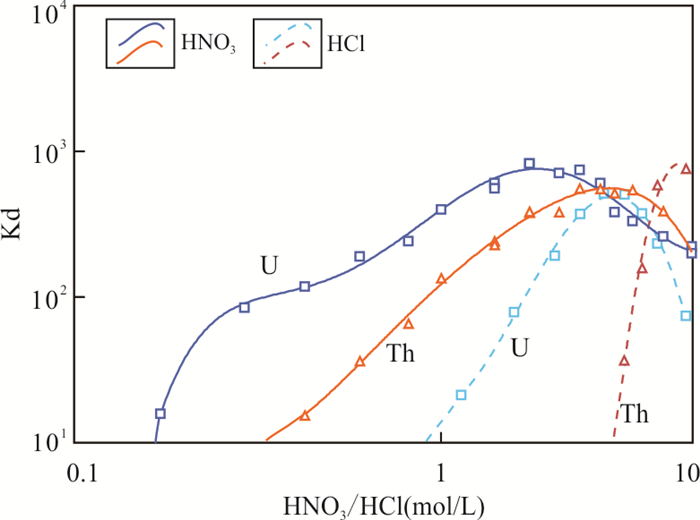
 下载:
下载:
